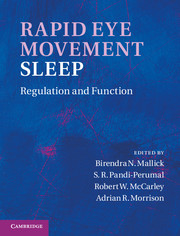Book contents
- Frontmatter
- Contents
- Contributors
- Preface
- Acknowledgments
- Organization
- Section I Historical context
- Section II General biology
- Section III Neuronal regulation
- 10 Understanding REM sleep: clues from brain lesion studies
- 11 Preoptic and basal forebrain modulation of REM sleep
- 12 Amygdalar regulation of REM sleep
- 13 Pontomedullary mediated REM-sleep atonia
- 14 Phenomenology and function of myoclonic twitching in developing rats
- 15 Pontine-wave generator: a key player in REM sleep-dependent memory consolidation
- 16 Hippocampal theta rhythm of REM sleep
- 17 Respiration during REM sleep and its regulation
- 18 Modulation of REM sleep by non-REM sleep and waking areas in the brain
- Section IV Neuroanatomy and neurochemistry
- Section V Functional significance
- Section VI Disturbance in the REM sleep-generating mechanism
- Index
- Plate section
- References
14 - Phenomenology and function of myoclonic twitching in developing rats
from Section III - Neuronal regulation
Published online by Cambridge University Press: 07 September 2011
- Frontmatter
- Contents
- Contributors
- Preface
- Acknowledgments
- Organization
- Section I Historical context
- Section II General biology
- Section III Neuronal regulation
- 10 Understanding REM sleep: clues from brain lesion studies
- 11 Preoptic and basal forebrain modulation of REM sleep
- 12 Amygdalar regulation of REM sleep
- 13 Pontomedullary mediated REM-sleep atonia
- 14 Phenomenology and function of myoclonic twitching in developing rats
- 15 Pontine-wave generator: a key player in REM sleep-dependent memory consolidation
- 16 Hippocampal theta rhythm of REM sleep
- 17 Respiration during REM sleep and its regulation
- 18 Modulation of REM sleep by non-REM sleep and waking areas in the brain
- Section IV Neuroanatomy and neurochemistry
- Section V Functional significance
- Section VI Disturbance in the REM sleep-generating mechanism
- Index
- Plate section
- References
Summary
Summary
The development of adult sleep is a complex process comprising the emergence and coalescence of sleep components and the consolidation of sleep into progressively longer bouts. Achieving adequate descriptions of infant sleep and its development requires the use of methods that are scaled to the structural and temporal properties of sleep at early ages. This chapter reviews work demonstrating in infant rats how measures of sleep–wake behavior (e.g., myoclonic twitching during REM sleep, high-amplitude movements during wakefulness) coupled with electromyography of skeletal muscle (e.g., nuchal muscle) reveal sleep–wake cycles that are highly structured in space and time. Consideration of other measures – for example, extraocular muscle and cortical activity – provides further support for the notion that adult sleep is constructed in an orderly fashion through the addition of components (e.g., delta waves) and alterations in the statistical structure of sleep and wake bouts. Neurophysiological recordings and lesions in the medulla, mesopontine region, hypothalamus, and forebrain indicate that the brain critically contributes to sleep–wake processes as early as the first postnatal week. Finally, sensory feedback produced by twitches of the limbs is transmitted to the contralateral somatosensory cortex (where cortical activity is also modulated by the corpus callosum) before being transmitted to the hippocampus. Thus, we are moving closer to a full description of sleep–wake processes in the newborn as well as an understanding of the contributions of sleep-related spontaneous activity to the self-organization of the nervous system.
- Type
- Chapter
- Information
- Rapid Eye Movement SleepRegulation and Function, pp. 130 - 139Publisher: Cambridge University PressPrint publication year: 2011



